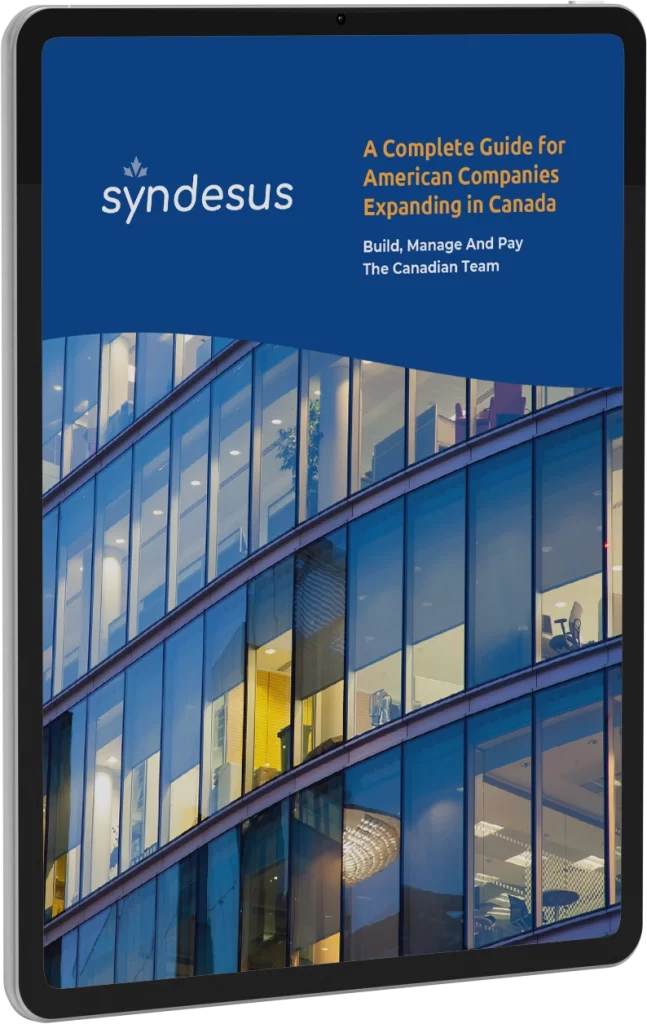Currently, there are more than 80 pathways for immigration to Canada. While all of these pathways have a similar goal — to bring a large number of immigrants into the country to contribute to Canada’s society and economy — not all pathways are created equal.
Canada’s immigration system has three main pathways: economic, family-sponsored, and refugee.
Canada’s economic immigration process, which brings skilled workers into the country, benefits both business and the Canadian labor market, and the economic pathways welcome the largest number of immigrants to Canada, with about 6 in 10 immigrants entering Canada on the basis of their positive economic impact.
According to Alex, US tech companies are “looking at coming up to Canada to open up an office, where immigration is a lot easier and a lot faster than the US.”
This impressive and ever-growing pool of skilled labor is a huge attraction for international companies considering expansion into Canada, explains Alex Khadempour, the managing director and a partner at CICS Immigration Inc.
“In Silicon Valley, tech companies want to come to Canada because they’re either foreign nationals themselves or they rely heavily on foreign talent,” Alex explains. “You know how difficult it is to find a skilled worker and how reliant many tech companies are on foreign nationals?”
According to Alex, US tech companies are “looking at coming up to Canada to open up an office, where immigration is a lot easier and a lot faster than the US.”
How are American companies making the move to Canada?
Alex, who has over 12 years of experience in the immigration industry, shared some details on how he has helped thousands of clients open new offices to expand their businesses in Canada through the Intra-Company Transferee program.
How the Intra-Company Transfer Program works
The Canadian Intra-Company Transfer program is so fascinating that we wrote an entire article about it, but here are the basics.
The Intra-Company Transfer program allows employees of an international company to move to Canada and get work authorization.
These employees must be moving to an existing parent, branch, or affiliate company in Canada, or looking to open up a new office in Canada. But not just any employee can move to Canada via ICT.
In order to qualify for the Intra-Company Transfer program, the employee you want to move to your Canadian office needs to check a few boxes:
- First, the applicant must have worked for the company for at least one year on a full-time basis.
- Second, they must have been offered a position with a Canadian branch, affiliate, or subsidiary of the foreign company.
- Third, they must fall into one of these three categories:
- Executives who receive only general supervision or no supervision from other executives, directors, or shareholders.
- Senior managers who supervise other managers or who manage essential functions within the business.
- Workers with specialized knowledge or an advanced level of expertise.
Typically, Intra-Company Transfer applicants qualify for a 2-week processing time under the Global Skills Strategy. Once accepted, the duration of the Intra-Company Transfer work permit is seven years for executives and senior managers and five years for specialized knowledge workers.
A majority of Intra-Company Transfer applicants move to Canada to work at an existing Canadian branch of their company, but Alex let us in on a little-known secret: It’s possible to use the Intra-Company Transfer work permit to move to Canada and start a new Canadian office.
Here’s what that means.
Open a new office in Canada with Intra-Company Transfer
Alex has assisted thousands of clients on their immigration journeys to Canada, so he knows firsthand how Canada’s immigration system can be both generous and restrictive.
“Currently there are about 150,000 people in the Express Entry pool of applicants. Out of this 150,000 people, each month, Canada goes into the pool and picks between 7,000 to 9,000 people. That means about 95% don’t get selected.” With a note of frustration, Alex adds, “it’s become just ridiculously competitive and difficult to immigrate to Canada.”
Express Entry is essentially a merit-based immigration system that allots visa applicants points for possessing certain qualities or skills.
Some examples include age, level of education, and an offer of employment, but it should be noted that the points system favors young, English- or French-speaking immigrants who are educated. Alex’s clients who are over 35-years-old struggle to get enough points with the Express Entry system, but he has a strategy.
For applicants who either own a business or hold an executive position with a company, they are able to enter Canada for the purposes of opening an office there.
“Through this special type of business executive work permit,” explains Alex, “they are able to get 200 points towards Express Entry, which makes up for points lost on age and potentially language skills.”
In order for this to work, you need to have a parent company that is well-established and you need to be able to prove this through tax documentation and financial reports.
You aren’t required to open the exact same office in Canada – it can be a spinoff, just as long as it’s related to the parent company and you bring in at least one executive to run the company.
Alex goes on to explain that the most qualified candidates for this program have “a post-secondary education, decent English, at least three years of work experience, and are under 40 years old.”
After 12 months in Canada as a temporary worker, you’re able to apply for permanent residency which is typically granted in four to 12 months.
According to Alex, for qualified candidates, the Intra-Company Transfer program is one of the best ways to immigrate to Canada, but how does it stack up against Canada’s other economic immigration pathways?
How ICT compares to the Provincial Nominee Programs and Express Entry
In addition to the Intra-Company Transfer program, there are two main economic immigration pathways in Canada, the Provincial Nominee Programs and Express Entry. Here are the basics of each:
The Provincial Nominee Programs allow provinces and territories in Canada to nominate people for immigration to their specific province. Each province and territory determines their own eligibility, and they tend to prioritize bringing in immigrants who can fill specific needs, like French-speaking doctors or civil engineers.
When considering the nomination, the province or territory considers the needs of their area, as well as the applicant’s genuine intention to settle there.
Alex points out that Canada’s entrepreneurial programs are all provincially based, so they have specific rules and requirements for application. “When you start your company, you have to run it for at least a year, sometimes a year and a half, sometimes two years, depending on the province,” explains Alex.
After meeting the requirements, running your business, hiring people, and investing money, you can approach the province for a nomination and then apply for permanent residency.
“All of these steps end up taking four and a half, five years until the person is a permanent resident. So not only is the processing time really long relative to other paths, but there are a lot of risks involved, and things can go wrong in a year and a half.”
Express Entry is another popular option for immigration to Canada. Express Entry was first introduced in 2015 and brings in more than 90,000 people annually.
…the biggest perk of the Intra-Company Transfer program is the overall ease of application, relative to the provincial entrepreneur programs, and follow-through.
It’s a competitive merit-based immigration system that ranks eligible candidates and ranks candidates against one another based on their age, education, language proficiency, work experience, and other factors.
The points system favors young, English- or French-speaking immigrants who are educated, so applicants who are over 35-years-old struggle to get enough points with the Express Entry system.
There are many benefits to pursuing an Intra-Company Transfer over other temporary work permit programs. Intra-Company Transfer has a faster application time because it doesn’t require a Labour Market Opinion which can take months to process.
Also, work permits are issued for a longer period of time than standard temporary foreign workers and they are between five years to seven years long, while standard work permits are up to four years. And for workers looking to make Canada their permanent home, the Intra-Company Transfer program can be leveraged in a future application for Canadian Permanent Residency.
For Alex, the biggest perk of the Intra-Company Transfer program is the overall ease of application, relative to the provincial entrepreneur programs, and follow-through.
“You show the relationship between the parent company and the applicants, and then once Canada accepts it, they don’t come back to audit your company,” Alex says about the process. “Sometimes some of my clients at the beginning say, ‘well, we’re going to be investing this much money and hire this many people.’ But sometimes plans change and you’re allowed to change your plan under Intra-Company Transfer. This is not the case for the majority of the Provincial entrepreneur programs.”
Flexibility, quick processing time, and length of work permit are all reasons you should consider the Intra-Company Transfer program for your immigration pathway into Canada.
The Intra-Company Transfer is Canada’s best-kept immigration secret
American companies are opening up offices in Canada now more than ever before and they’re bringing more employees into Canada. Some of these employees have been stuck in the H-1B process and were struggling to immigrate to the US for work.
Opening an office in Canada through the Intra-Company Transfer program gives you access to a diverse labor pool and eases immigration for your current and future employees, but — shockingly — few people take advantage of this immigration pathway.
“A lot of lawyers and consultants actually don’t know about this path,” Alex admits. But he warns that if the Intra-Company Transfer program piques your interest, you should move fast. “I wouldn’t be surprised if in one or two years everybody jumps on Intra-Company Transfer, it becomes saturated and the Canadian government changes the laws and makes it more difficult.”
Thinking about opening up an office in and expanding into Canada?
Syndesus can help you establish your Canadian presence and after you’ve opened your Canadian office, we can even help you find a Canadian software engineer (or a team of them) via our recruiters all across the country. Want to hear more? Let’s connect to see if we can help you and your company make the move into Canada!

